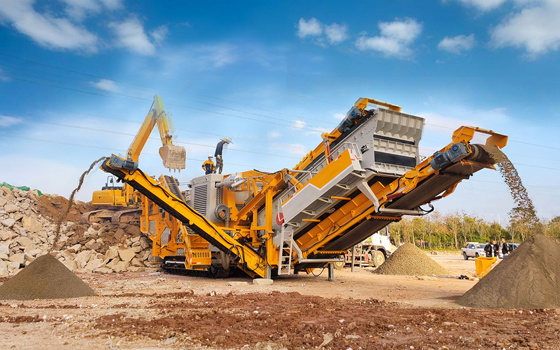Discover the Essential Components of Impact Crushers for Optimal Performance
Release Time:
2025-07-29
Author:
Source:
Discover Essential Components of Impact Crushers Table of Contents 1. Introduction to Impact Crushers 2. Understanding the Mechanism of Impact Crushing 3. Key Components of Impact Crushers 3.1 Rotor Assembly 3.2 Blow Bars 3.3 Impact Plates 3.4 Feed System 3.5 Discharge System 4. The Role of Each Component in Crushing Efficiency 5. Maintenance Tips for Optimal Performance 6.
Discover Essential Components of Impact Crushers
Table of Contents
1. Introduction to Impact Crushers
2. Understanding the Mechanism of Impact Crushing
3. Key Components of Impact Crushers
3.1 Rotor Assembly
3.2 Blow Bars
3.3 Impact Plates
3.4 Feed System
3.5 Discharge System
4. The Role of Each Component in Crushing Efficiency
5. Maintenance Tips for Optimal Performance
6. Troubleshooting Common Issues with Impact Crushers
7. The Future of Impact Crushing Technology
8. Conclusion
9. Frequently Asked Questions (FAQs)
1. Introduction to Impact Crushers
Impact crushers play a pivotal role in various industries, primarily in the manufacturing and processing of materials. These machines are designed to crush a wide range of materials, including rocks and minerals, into smaller, more manageable sizes. Essential for operations in construction, mining, and recycling, impact crushers utilize high-speed impact to break down materials efficiently. Understanding the components of these machines is vital for anyone involved in their operation or maintenance.
2. Understanding the Mechanism of Impact Crushing
Impact crushing is a dynamic process that involves the application of force to break materials apart. Unlike traditional crushers that rely on compression, impact crushers utilize high-velocity impacts to shatter materials. This process not only enhances efficiency but also allows for a finer output product. The key to effective impact crushing lies in the design and functionality of its components, which work in harmony to achieve optimal performance.
3. Key Components of Impact Crushers
To appreciate how impact crushers operate, it’s crucial to understand their essential components. Each part plays a unique role in the crushing process, contributing to the overall effectiveness of the machine.
3.1 Rotor Assembly
The rotor assembly is the heart of the impact crusher. It consists of a high-speed rotating shaft that drives the blow bars. The rotor's speed and design directly affect the machine's crushing efficiency. A well-balanced rotor ensures that the impact energy is evenly distributed, resulting in consistent material size reduction.
3.2 Blow Bars
Blow bars are critical components that directly interact with the material being crushed. Made from various materials, including high chromium steel and tungsten carbide, blow bars absorb the impact energy and strike the material to fracture it. The choice of blow bar material can significantly influence wear resistance and overall crushing performance.
3.3 Impact Plates
Impact plates, or aprons, serve as the surface against which the material is struck by the blow bars. They are designed to absorb and redirect the impact force, allowing for effective material reduction. Adjusting the gap between the impact plates and blow bars can alter the size of the crushed material, making this component crucial for achieving desired product specifications.
3.4 Feed System
The feed system is responsible for delivering raw materials into the crusher. It can vary in design, from gravity-fed systems to those equipped with vibrating feeders. A well-designed feed system ensures a continuous flow of material, maximizing the efficiency of the impact crushing process.
3.5 Discharge System
After the crushing process, the discharge system plays a vital role in removing the processed material from the machine. This system typically consists of conveyors or chutes that transport the crushed material to the next stage in the production process. Efficient discharge systems prevent bottlenecks and ensure a steady flow of output.
4. The Role of Each Component in Crushing Efficiency
Understanding how each component contributes to crushing efficiency is essential for optimizing the performance of an impact crusher. The rotor assembly's speed and balance directly influence the impact force applied to the material. Blow bars must be selected based on their material properties to withstand wear and tear while providing effective impact. Impact plates must be adjustable to accommodate different material sizes and achieve desired output. A well-designed feed system maintains a consistent material flow, while a reliable discharge system ensures that the crushed material is efficiently removed.
5. Maintenance Tips for Optimal Performance
Regular maintenance is crucial for ensuring the longevity and efficiency of impact crushers. Here are some essential tips:
- **Routine Inspections**: Conduct regular inspections to check for wear and tear on blow bars, impact plates, and the rotor assembly.
- **Proper Lubrication**: Ensure all moving parts are adequately lubricated to reduce friction and wear.
- **Adjustments**: Regularly adjust the gaps between blow bars and impact plates to maintain desired output sizes.
- **Cleaning**: Keep the machine clean from dust and debris to prevent operational issues.
- **Replacement Scheduling**: Replace worn out parts promptly to avoid compromising performance.
6. Troubleshooting Common Issues with Impact Crushers
Even the best-maintained impact crushers can experience issues. Here are some common problems and their potential solutions:
- **Reduced Crushing Efficiency**: This may result from worn blow bars or improper rotor balance. Regularly check and replace these components as needed.
- **Excessive Vibration**: Unbalanced rotors or loose components can cause excessive vibration. Ensure all parts are properly secured and balanced.
- **Blockages**: Material buildup in the feed or discharge system can lead to operational inefficiencies. Regularly clean these areas to prevent blockages.
7. The Future of Impact Crushing Technology
As technology advances, so does the design and functionality of impact crushers. Innovations such as automated systems for monitoring performance, advanced materials for blow bars, and enhanced safety features are shaping the future of impact crushing. Understanding these trends can help businesses prepare for the next generation of crushing technology.
8. Conclusion
Impact crushers are essential machines in various industries, providing efficient solutions for material size reduction. By understanding the fundamental components and their roles in the crushing process, operators can maximize performance and ensure longevity. Regular maintenance and staying informed about technological advancements will further enhance operational efficiency.
9. Frequently Asked Questions (FAQs)
1. What types of materials can be processed by impact crushers?
Impact crushers can process a wide range of materials, including limestone, granite, and concrete.
2. How often should maintenance be performed on an impact crusher?
Maintenance should ideally be performed on a routine basis, including daily checks and more in-depth inspections weekly or monthly.
3. Can impact crushers be used for recycling purposes?
Yes, impact crushers are commonly used in recycling applications to process materials like asphalt and concrete.
4. What is the difference between an impact crusher and a jaw crusher?
Impact crushers utilize high-speed impacts to fracture materials, while jaw crushers employ compression to crush materials.
5. How can I improve the efficiency of my impact crusher?
Improving efficiency can be achieved by regularly maintaining components, ensuring a proper material feed, and using high-quality blow bars.
This comprehensive exploration of impact crushers not only highlights their essential components but also provides valuable insights into maintenance and future developments. By focusing on performance, operators can achieve significant improvements in their crushing processes.
Keywords:
Jaw crusher parts | Shredder parts | Cone crusher Parts | Ball mill parts
Previous page
Previous page:
Related News
Business License









